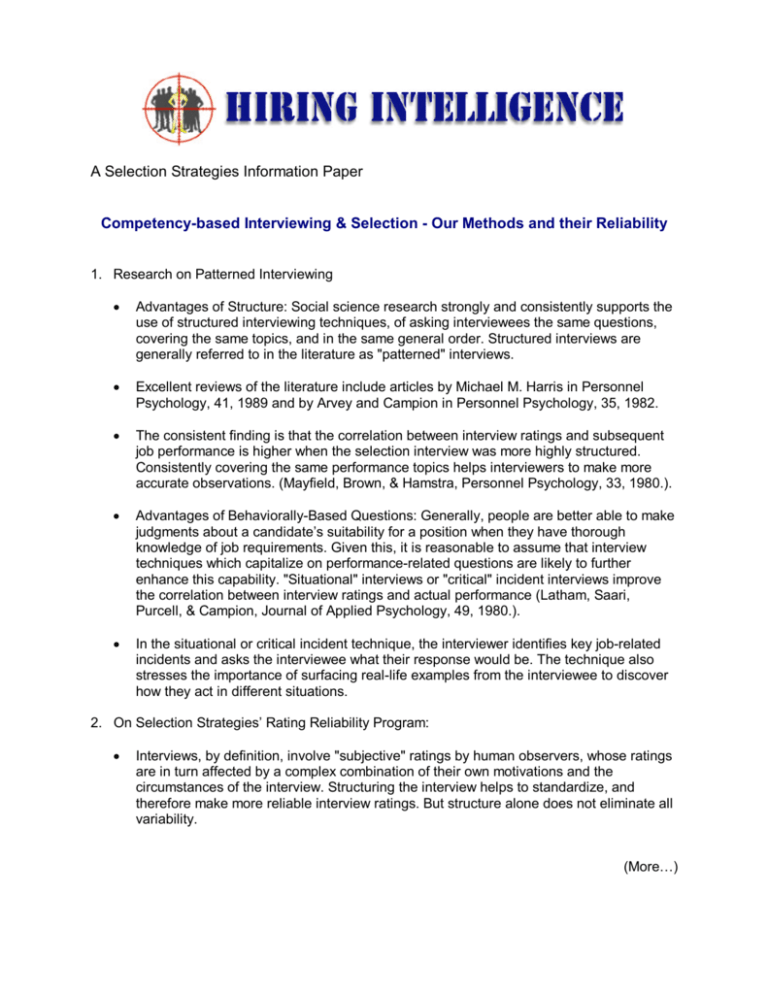
A Selection Strategies Information Paper
Competency-based Interviewing & Selection - Our Methods and their Reliability
1. Research on Patterned Interviewing
• Advantages of Structure: Social science research strongly and consistently supports the
use of structured interviewing techniques, of asking interviewees the same questions,
covering the same topics, and in the same general order. Structured interviews are
generally referred to in the literature as "patterned" interviews.
• Excellent reviews of the literature include articles by Michael M. Harris in Personnel
Psychology, 41, 1989 and by Arvey and Campion in Personnel Psychology, 35, 1982.
• The consistent finding is that the correlation between interview ratings and subsequent
job performance is higher when the selection interview was more highly structured.
Consistently covering the same performance topics helps interviewers to make more
accurate observations. (Mayfield, Brown, & Hamstra, Personnel Psychology, 33, 1980.).
• Advantages of Behaviorally-Based Questions: Generally, people are better able to make
judgments about a candidate’s suitability for a position when they have thorough
knowledge of job requirements. Given this, it is reasonable to assume that interview
techniques which capitalize on performance-related questions are likely to further
enhance this capability. "Situational" interviews or "critical" incident interviews improve
the correlation between interview ratings and actual performance (Latham, Saari,
Purcell, & Campion, Journal of Applied Psychology, 49, 1980.).
• In the situational or critical incident technique, the interviewer identifies key job-related
incidents and asks the interviewee what their response would be. The technique also
stresses the importance of surfacing real-life examples from the interviewee to discover
how they act in different situations.
2. On Selection Strategies’Rating Reliability Program:
• Interviews, by definition, involve "subjective" ratings by human observers, whose ratings
are in turn affected by a complex combination of their own motivations and the
circumstances of the interview. Structuring the interview helps to standardize, and
therefore make more reliable interview ratings. But structure alone does not eliminate all
variability.
(More… )
A Selection Strategies Information Paper - Competency-based Interviewing & Selection - Our Methods and their Reliability (cont'd)
• Some of the studies cited earlier regard a .72 correlation between interview ratings and
subsequent supervisor ratings as highly reliable, and therefore "successful". In fact,
some studies regard a .46 or .30 correlation as sufficient enhancement of the decisionmaking process. This is primarily because most "unstructured" interviews (i.e.,
"traditional" job interviewing) tends to have an exceptionally low level of accuracy,
reported by one researcher as no greater than .14 (Ofsanko, Industrial Psychologist, 20,
1983.).
Typical Validity Assessment, Dr. V.S. Harvey, 1995.
3. Rationale for a Qualitative Interview
• Uncovering Complex Information and Motivational Information: The open-ended nature of
the patterned interview still leaves room for variability, both in terms of the kinds of
responses that are prompted, and in the way these responses are analyzed and
interpreted.
• Inevitably, this means a loss of some reliability. However, the gains are very significant,
especially when the goals of the interview are considered. In particular, open-ended
interviewing allows for greater probing to understand why an individual is giving certain
responses. It allows the individual to pace themselves and use their own terms for
describing their attitudes and behaviors. The person gets a chance to explain themselves
in their own terms rather than being explained according to results on a pencil and paper
or computer-scored test.
• Multiple Uses of Information: The interview produces a wealth of information that can be
used for short-term and long-term objectives. It provides valuable information that helps
management not only in making a hiring decision, but also in the successful management
of the candidate once hired.
(More… )
A Selection Strategies Information Paper - Competency-based Interviewing & Selection - Our Methods and their Reliability (cont'd)
• Appropriate Use of the Instrument: The Hiring Intelligence In-Depth Interviews and
selection process are essentially analytical tools. They help us reflect consistently and in
performance-relevant ways about the information the candidate provides. The In-Depth
Interview is not intended to be a "silver bullet," or to replace managerial judgment.
Instead, it is a tool that assists and supports managerial judgment. Human behavior is
seldom black or white. Desirable behavior may change from situation to situation or may
be seen as more manageable in one situation than another. The In-Depth Interview
provides the kind of complex, situation-based information that helps the attentive,
well-trained manager to make an informed judgment call.
4. Interview Instrument and Process
• The research instrument used is the Hiring Intelligence In-Depth Interview ("IDI"). The
interviews are conducted by telephone with the subject in a relaxed, private location.
Each interview lasts approximately 2 - 2 ½ hours.
• The IDI consists of a number of behavior description questions supplemented with
focused follow-up questions (i.e., "drill downs").
• This data gathering technique captures in-depth, case specific information that enables
Selection Strategies to explore a candidate's prior success.
• The result is a Behavioral Profile that illustrates, in a composite view and on a 1-10 scale,
the degree to which each study participant exercises each of 16 Behavioral Traits.
• The interviews are conducted by interviewers trained in the definition and identification of
the Behavioral Traits by Judith Sears, founder of the Strategic Staffing Group, a Selection
Strategies partner company. Ms. Sears developed the interview in conjunction with
Selection Strategies.
• Emphasis is placed on probing for detailed examples to gain perspective on how the
subject is driven, thinks, acts and interacts in different situations.
• Attitudinal probes are asked throughout the interview, both to confirm the information
gathered in the examples and to broaden the base of information collected.
• The interviews are tape-recorded, transcribed and sent to Selection Strategies for
analysis.
• Accompanying the interview are the interviewer’s written impressions of the participant.
The interviewer rates the participant's communication and interpersonal skills, and notes
any behavior or actions that may not be discerned from reading the interview transcript
(e.g., participant’s mood/attitude toward the interview process, questions that were
particularly difficult for the participant to answer, etc.).
• Our analysts are also trained and certified, and bring over 8 years experience in
assessing these behavioral interviews.
• To be a Certified Coder, the analyst must achieve a 90% or better consistency rating
based on analyzing and scoring at least 6 consectutive interviews. All analysts complete
the same training regimen to ensure inter-coder reliability and consistency.
• The Selection Strategies Analyst reads the verbatim interview transcript and scores the
behavioral information surfaced throughout, either in questions designed to surface a
specific behavior or in questions looking for different behaviors. A specific point and
scoring system is followed, and is totaled after the entire interview has been reviewed.
The participant is given individual scores in each of 16-18 measured Behavioral Traits.
(More… )
A Selection Strategies Information Paper - Competency-based Interviewing & Selection - Our Methods and their Reliability (cont'd)
The scores illustrate the extent or frequency to which the individual exercises a given
behavior.
• The scoring range of 1-10 per trait describes a spectrum from little used to excessive or
dominant. Although no such label is truly appropriate, an "ideal range" lies between 6 & 8.
This reflects behaviors that are consistently practiced, but are not so excessive as to
pose significant drawbacks from their strength or from group cohesiveness and
performance.
2000, Selection Strategies, Inc. All Rights Reserved.
Competitive Superiority Through Talented People








